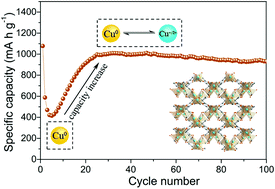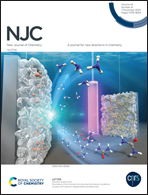A green ligand-based copper–organic framework: a high-capacity lithium storage material and insight into its abnormal capacity-increase behavior†
Abstract
Metal–organic frameworks (MOFs) are believed to be potential lithium storage materials for their redox activity that can uptake electron and porosity that in turn can favor ion transport and storage. To boost their performance and practical use, in this work, a green and cheap ligand citrate is first used in constructing a Cu-based MOF anode. The as-prepared Cu-CIT exhibits excellent capacity, stability, and rate capability, with the capacities of 608.5 and 321.5 mA h g−1 at 1 and 2 A g−1 after 500 cycles, being the best one among Cu-based MOFs. Moreover, its abnormal capacity-increase behavior is also observed and elaborately investigated through ex situ electron paramagnetic resonance (EPR) and X-ray absorption fine structure (XAFS). These results reveal the gradual redox participation of metal centers during cycles which for the first time shed light on the progressive activated process of MOFs in LIB applications.



 Please wait while we load your content...
Please wait while we load your content...